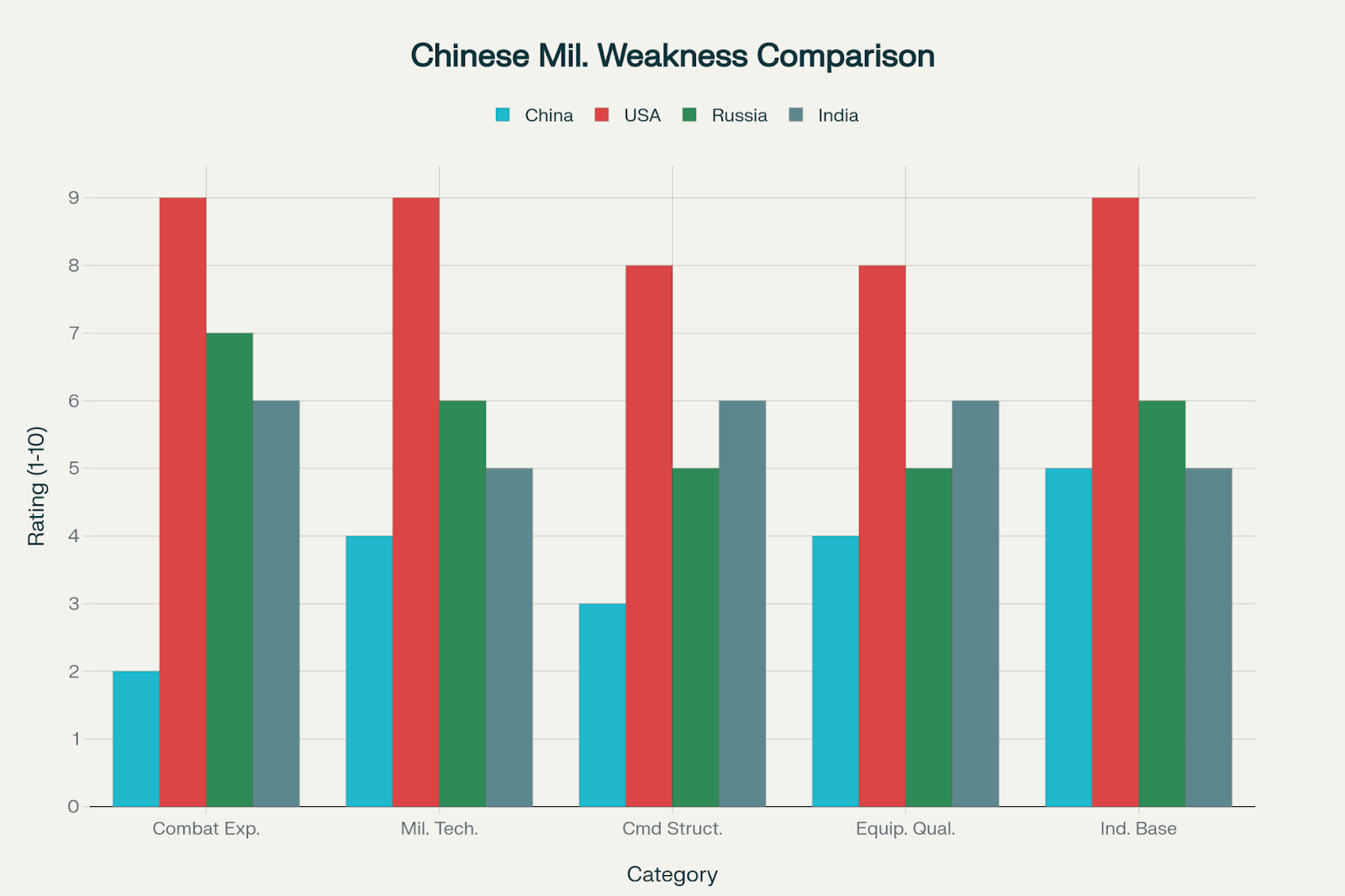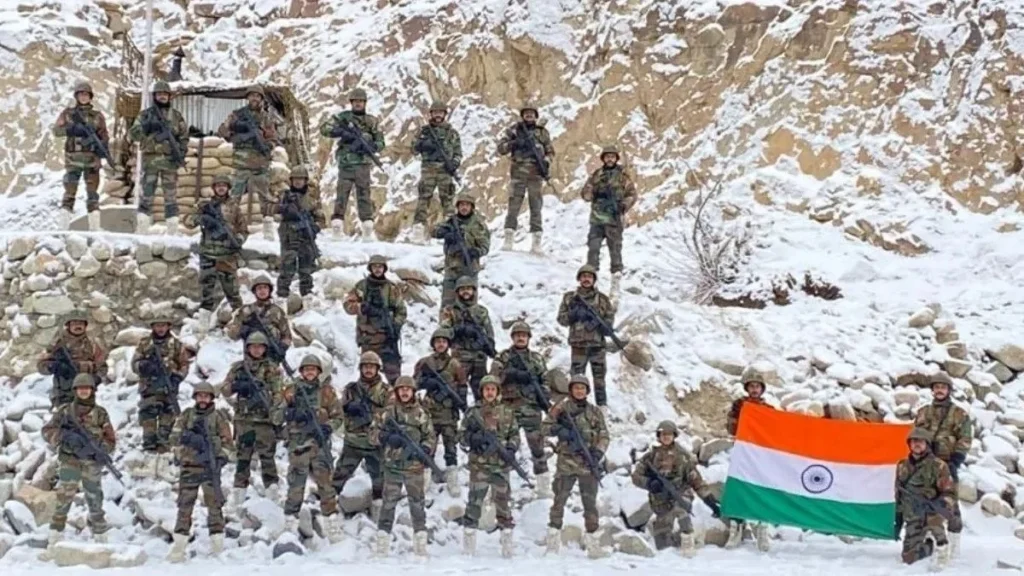Despite commanding the world’s largest military by numbers, housing over 2 million active personnel, and boasting an impressive array of modern weaponry, China’s People’s Liberation Army remains fundamentally unproven and plagued by systemic weaknesses that no amount of propaganda can disguise. You know, if military superpowers came with instruction manuals, China seems to have found the exact opposite, a step-by-step guide on “How Not to Be a Superpower.” And with this article, we’re diving deep into this masterclass in military mediocrity . Today, we’re pulling back the curtain on why China’s military, despite its impressive parade formations and technological displays, falls short of true superpower status.
- The Corruption Crisis: Water-Filled Missiles and Broken Dreams
- The Experience Gap: Decades of “Peace Disease”
- The Command Structure Problem: Party Over Performance
- Technology Gaps: The Reverse Engineering Problem
- The Numbers vs. Quality Deception
- Also Read, F-22 Raptor vs J-20 Mighty Dragon
- The Human Factor
- Morale Matters
- Industrial Base Vulnerabilities
- Strategic Implications: Why This Matters
- Conclusion: The Superpower That Isn’t
We’re about to explore the greatest military illusion of the 21st century – how to look terrifying on paper while being absolutely underwhelming in reality. This is your complete breakdown of why China’s military, despite its impressive parade formations and technological displays, has turned “How Not to Be a Superpower” into an art form.
The Corruption Crisis: Water-Filled Missiles and Broken Dreams
The most damaging revelation about China’s military came from US intelligence assessments in 2024, exposing a corruption scandal so severe it shook President Xi Jinping’s confidence in his own forces. The People’s Liberation Army Rocket Force, China’s premier nuclear and missile arm, was found to have missiles filled with water instead of fuel and missile silos with lids that don’t function properly, preventing effective launches.
This wasn’t isolated incompetence-it represented systemic corruption throughout China’s military-industrial complex. The scandal led to the removal of over a dozen senior commanders, including consecutive Defense Ministers Li Shangfu and potentially Dong Jun. US officials now believe these corruption issues have made Xi “less likely to contemplate major military action” in the near term.
The corruption extends beyond just equipment failures. Admiral Miao Hua, the fourth-highest military leader and head of political work, was suspended in 2024 for “serious violations of discipline”—Chinese euphemism for corruption. This marked the seventh serving or former Central Military Commission member purged since Xi took power in 2012.

The Experience Gap: Decades of “Peace Disease”
Xi Jinping himself has acknowledged China’s critical weakness: what Chinese analysts call “peace disease” the deterioration of military capability due to lack of combat experience. The PLA’s last significant military engagement was the disastrous 1979 war against Vietnam, which China decisively lost despite numerical superiority.
The Vietnam conflict exposed fundamental PLA weaknesses that persist today. Chinese forces suffered approximately 60,000 casualties while failing to achieve their primary objective of forcing Vietnamese withdrawal from Cambodia. Vietnamese commanders were reportedly surprised by how poorly the Chinese performed, with PLA forces relying on outdated Korean War-style tactics and suffering from poor command structures.
More embarrassingly, in 2016, a Chinese UN peacekeeping battalion in South Sudan abandoned their post and fled, leaving weapons and ammunition behind when faced with South Sudanese forces – hardly a formidable opponent. This represents the extent of China’s “modern combat experience.”
The Command Structure Problem: Party Over Performance
Unlike professional militaries that prioritize merit-based leadership, the PLA operates under a dual-command structure where political commissars share authority with military commanders. Every ship, unit, and squadron has both a military commander and a political commissar who must reach consensus through party committees before making tactical decisions.
This system creates dangerous delays in rapidly evolving combat situations. As one expert noted, “it’s time-consuming in a rapidly developing emergency”. The commissar evaluates the commander’s decisions and can overrule military judgment for political reasons.
The PLA spends up to 40% of training time on political topics rather than combat skills. Promotions are based on political reliability rather than battlefield merit, creating an officer corps more loyal to Communist Party orthodoxy than military effectiveness.
Technology Gaps: The Reverse Engineering Problem
Despite China’s reputation for technological advancement, its military remains heavily dependent on foreign technology and faces critical gaps in key areas. China’s semiconductor dependence is particularly acute—the PLA relies on American-designed chips for AI capabilities while being years behind in domestic production.
Chinese military technology development follows a pattern of reverse engineering rather than genuine innovation. From fighter jets to missile systems, Chinese weapons are largely copies of Russian, American, or Israeli designs. This approach creates fundamental limitations:
- Quality control problems: Chinese weapons consistently underperform in real combat situations
- Maintenance issues: Countries using Chinese equipment report frequent breakdowns and poor after-sales support
- Technical gaps: Reverse engineering cannot replicate the tacit knowledge and manufacturing expertise behind original designs
Recent combat tests have been devastating for Chinese equipment reputation. During Operation Sindoor, Pakistani forces using Chinese weapons systems experienced widespread failures. Chinese HQ-9 air defense systems failed to intercept Indian missiles, PL-15 air-to-air missiles malfunctioned, and J-10C fighter jets underperformed.
The Numbers vs. Quality Deception
While China boasts impressive military statistics – 2.3 million active personnel, the world’s largest navy by hull count, and massive defense budgets- these numbers mask serious qualitative deficiencies, even when considering their most advanced systems.
The J-20 Reality Check: China has indeed ramped up production of its J-20 “Mighty Dragon” stealth fighter, with current estimates suggesting over 250 aircraft produced by 2024, at a rate of approximately 100 aircraft per year. This represents a significant achievement and has allowed China to field more fifth-generation fighters than the US F-22 Raptor fleet of 187 aircraft.
Also Read, F-22 Raptor vs J-20 Mighty Dragon
However, the J-20’s impressive production numbers hide critical performance limitations:
Stealth Compromises: Independent radar cross-section analyses reveal the J-20’s stealth capability is significantly inferior to American counterparts. While the F-22 has an RCS of 0.001 to 0.01 m², the J-20’s RCS is estimated at 0.1 to 1 m² potentially 100 times larger. Although some other estimates place its frontal RCS closer to 0.05 m² to 0.1 m² , possibly representing different aspects or configurations. The exact RCS is classified. But most of the analysts believed NATO radars can detect J-20s at over 120 kilometers compared to 70-90 kilometers for an F-22.
Engine Problems: Despite claims of success, the J-20’s WS-15 engine program continues facing reliability issues. Most J-20s still rely on Russian AL-31 engines or the underpowered WS-10C, limiting supercruise capability and creating visible thermal signatures that compromise stealth. The engines lack thrust vectoring and produce insufficient power for optimal performance.
Manufacturing Quality: Even with increased production, quality control remains problematic. The J-20 has never been tested in actual combat, unlike American systems proven in multiple conflicts. Its forward canards, while improving maneuverability, significantly compromise stealth from certain angles.
Limited Export Success: Tellingly, despite China’s export push with variants like the J-31/J-35, no foreign customers have committed to purchasing the J-20 itself, while the F-35 has over 20 international partners. Even Pakistan, a close ally of China, has reportedly refused the purchase of 40 J-35 variants, as confirmed by its Defense Minister. This comes after the deal was earlier hyped by both Chinese and Pakistani media.
The Brookings Institution’s analysis reveals China’s military as “simply not very good”. Most Chinese forces serve in ground units that “lack transport and mobile logistics assets” and are “more aptly described as internal security personnel”. Their training ranges from “spotty to poor,” and the forces remain “plagued by poor pay, nepotism and party favoritism. While China produces other modern fighters like the J-16 and J-10C, most of their air force still relies on outdated technology.
This creates a quality gap disguised by quantity. China may field impressive numbers of aircraft, but the vast majority lack the technological sophistication and proven reliability of Western equivalents. The J-20, while representing genuine progress, remains an unproven system with significant limitations masquerading as a peer competitor to battle-tested American fighters.
Similarly, During galwan valley clash, despite its numerical superiority and modern kit, the PLA suffered its highest combat losses in over four decades during the June 2020 Galwan Valley clash with India. Independent investigations estimate 35 – 50 Chinese soldiers killed compared to 20 Indian fatalities. These casualties underscore that even vast numbers and equipment cannot compensate for deficient training, poor operational planning, and weak small-unit leadership.

The Human Factor
It’s not just about the machines-it’s about the men and women behind them. A shocking incident on August 11, 2025, exposed just how poorly trained and coordinated Chinese naval forces really are. During a routine harassment operation against Philippine Coast Guard vessels near Scarborough Shoal, two Chinese ships collided with each other in what can only be described as a spectacular display of incompetence. The China Coast Guard cutter CCG-3104 was pursuing the small Philippine vessel BRP Suluan at high speed when it slammed bow-first into China’s own PLA Navy destroyer Guilin a 7,500-ton, $1 billion warship.
The collision was so severe that it completely crushed the Coast Guard vessel’s bow, rendering it unseaworthy and likely causing casualties among the Chinese crew members who were visible on deck moments before impact. Video footage captured the entire embarrassing sequence: Chinese ships using water cannons against a much smaller Philippine vessel, then their own forces crashing into each other while trying to execute what should have been a basic pincer movement.
What makes this even more damaging is that the Philippine Coast Guard immediately offered medical assistance and search-and-rescue support to the Chinese crews an offer that was completely ignored by Beijing. Instead of acknowledging the accident, Chinese officials initially tried to cover up the collision entirely, with state media carefully editing footage to hide their forces’ incompetence.
Maritime experts have pointed to “poor coordination between Chinese forces” as the key factor, with the destroyer and coast guard operating without proper communication. This wasn’t combat stress or enemy action this was basic seamanship failure during what should have been routine operations.
As one analyst noted: “This incident highlights Beijing’s disregard for maritime safety and calls into question the seamanship of Chinese forces”. The Philippine Coast Guard, meanwhile, demonstrated “impressive courage and professionalism” while being pursued by vessels many times their size.
The contrast is telling: a small, outgunned Philippine vessel successfully outmaneuvered two larger Chinese ships, which then crashed into each other in their confusion. If China’s naval forces can’t coordinate a simple harassment operation without damaging their own ships, how would they perform in actual combat against a determined enemy?
This incident perfectly encapsulates China’s fundamental military weakness, impressive hardware operated by poorly trained, poorly coordinated personnel operating under a command structure that prioritizes politics over professionalism.
This shows that even with advanced equipment, the human element – training, coordination, and seamanship remains China’s critical weakness. It also shows their tendency to cover up failures rather than learn from them, which is a key characteristic of authoritarian militaries.
Morale Matters
China’s conscript-style rotation system and emphasis on political loyalty over unit cohesion have eroded frontline morale. Unlike professional volunteer armies, many PLA recruits face short tours, minimal combat pay, and heavy political indoctrination, factors that breed cynicism rather than esprit de corps. High desertion rates during harsh winter patrols and a spike in non-combat injuries indicate a force stretched thin in will as well as skill.
These human-centric failures show that morale, leadership, and training remain the true force multipliers or killers in modern warfare. Even with cutting-edge hardware and immense manpower, a disheartened, undertrained force will falter.
Industrial Base Vulnerabilities
China’s defense industry faces systematic weaknesses that undermine its military modernization goals. The country’s arms exports have declined by 5.3% during 2019-2023, with customers increasingly dissatisfied with Chinese equipment quality.
Major quality problems include:
- Nigerian F-7 aircraft: Lost 3 of 12 aircraft to crashes within a decade
- Algerian CH-4 drones: Numerous crashes during testing in 2020-2021
- Bangladesh K8-W aircraft: Problems with ammunition firing systems
- Pakistani F-22P frigates: Unable to fire missiles due to defective sensors and radar systems
The Made in China 2025 plan aimed for 40% of global semiconductor production by 2020, but China achieved only a fraction of this goal. The country remains critically dependent on foreign technology, particularly from Taiwan and South Korea, for advanced semiconductors essential to modern military systems.
Strategic Implications: Why This Matters
These systematic weaknesses have profound implications for China’s military ambitions:
Taiwan Invasion Capability: The combination of inexperienced forces, unreliable equipment, and command structure problems makes a successful Taiwan invasion highly questionable, especially against determined resistance backed by US support.
Global Power Projection: Without reliable logistics, proven combat systems, and experienced personnel, China cannot effectively project power beyond its immediate neighborhood.
Deterrence Failure: As corruption scandals and equipment failures become public, China’s military deterrent effect diminishes, potentially encouraging adversaries and disappointing allies.
Economic Burden: Massive defense spending on unreliable systems represents a significant drain on China’s economy without proportional security gains.
Conclusion: The Superpower That Isn’t
China’s military represents a classic example of how quantity cannot substitute for quality, and how authoritarian control mechanisms undermine military effectiveness. Despite decades of investment and modernization efforts, the PLA remains hampered by:
- Systemic corruption that undermines equipment reliability
- Lack of combat experience and realistic training
- Political control systems that prioritize loyalty over competence
- Dependence on foreign technology and reverse engineering
- Poor quality control in domestic military production
The lesson for other nations is clear: building a truly capable military requires more than just money and numbers. It demands professional leadership structures, genuine innovation capacity, rigorous quality control, and most importantly, a culture that values military effectiveness over political conformity.
China may look formidable on paper and in carefully choreographed military parades, but when it comes to actual warfare capability, it remains years behind true military superpowers. The emperor’s new army, it turns out, has no clothes. And there you have it, China’s complete guide to “How Not to Be a Superpower” – a masterclass they never intended to teach.




